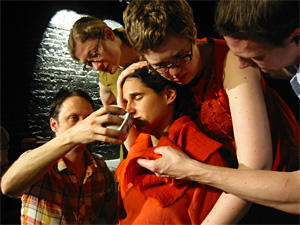
The Sound and the Fury • Press
- The New York Times May 21, 2015
- TimeOut New York January 20, 2015
- Entertainment Weekly May 21, 2015
- Theatermania May 21, 2015
- Exeunt Magazine May 21, 2015
- New York Post May 21, 2015
- New York Daily News May 22, 2015
- Theater Pizzazz! May 21, 2015
- Huffington Post May 21, 2015
- The Bergen Record May 22, 2015
- The Advertiser March 12, 2010
- The Australian March 15, 2010
- Expresso-Actual January 24, 2009
- Publico January 20, 2009
- The New Yorker May 26, 2008
- The New Yorker May 5, 2008
- The New York Times April 30, 2008
- Time Out New York April 30-May 6, 2008
- Time Out New York April 30, 2008
- The New York Sun April 30, 2008
- The International Herald Tribune April 29, 2008
- Backstage April 29, 2008
- Variety April 29, 2008
- The New York Times April 27, 2008
- Variety November 30, 2007
- The Brooklyn Rail April 2008
- Variety November 30, 2007
Spring Theater Preview – The Sound And The Fury, An Idiot’s Tale: ERS Follows Up Fitzgerald With Faulkner
by Alexis Soloski
In 1929, William Faulkner presented the typed manuscript of The Sound and the Fury to his literary agent with the warning, “It’s a real sonofabitch.” Elevator Repair Service’s John Collins can’t help but agree. “I’m with him on that,” he sighs. For over a year, Collins has steeped himself in the novel with the aim of directing a verbatim stage adaptation of its first chapter, a production that begins previews at New York Theatre Workshop on April 5. The Sound and the Fury (April 7th, 1928) will mark ERS’s first-ever mainstage Off-Broadway production.
The novel The Sound and the Fury consists of four sections: the first told by Benjy Compson, whom Faulkner bluntly describes as “an idiot”; the second by his elder brother Quentin; the third by his eldest brother Jason; and the last by a third-person narrator. Originally, ERS attempted to secure the rights to the entire novel, but they believed those rights were not available. (A representative for the Faulkner Estate demurs.) Nevertheless, the estate and ERS agreed on the rights to the Benjy section. A contretemps with the Fitzgerald estate has prevented ERS from staging Gatz, their acclaimed version of The Great Gatsby, in New York. The company wanted to avoid any similar complication for this show.
Having spent years assembling and touring Gatz, one wouldn’t have expected ERS to turn immediately toward another great American novel. Or another novel at all. But in their 16 years as an Off-Off-Broadway company, ERS have rarely made predictable choices: Their show Cab Legs paraphrased Tennessee Williams and Bollywood films; Room Tone performed The Turn of the Screw in the dark; Highway to Tomorrow, their version of The Bacchae, featured a thermos in a lead role. “We get tired of doing the same thing,” says Collins. When choosing a new project, “We always say, ‘What would we never do?’. . . This time around, [a group member] jokingly proposed at a meeting, ‘Well, I guess the thing we’d never do at this point is the same thing twice.’ So we said, ‘OK, we’ll do another novel.’ ”
Many in ERS had long admired Faulkner. For weeks they worked through his canon, reading the books aloud to one another. (How their heads must have been swimming with incest, madness, and horror.) Collins recalls that the Benjy section “seemed the most transformed by being read aloud. The intimidating narrative structural complexity lightened.”
In an essay, Faulkner insisted: “The story is all there, in the first section as Benjy told it. I did not try deliberately to make it obscure.” But it is obscure, for the reader and likely for the audience member. Benjy has the intellect of a very young child, yet he possesses a powerful, almost photographic memory. A word, a sight, a smell can send him spinning into the past. In his section of the novel, he remembers 20 different eventsÑ some of them as many as a dozen timesÑall jumbled out of order. Throughout, he remains mute.
Susie Sokol, who shares the role with Aaron Landsman, at first resisted playing Benjy. Collins assigned it to her “because I’d missed a few rehearsals,” she says. “I was really mad, because I wouldn’t be able to speak. We had fisticuffs with each other.” But she’s come to embrace the role, observing her classroom of St. Ann’s second-graders (Sokol’s day job) to prepare.
Collins, Sokol, Landsman, 10 other cast members, and the design team have a month before the show’s first preview, and lots left to do. A work-in-progress showing in January revealed a spirited, disarming, but confusing piece- the actors frequently switching roles with little regard to appropriate race or gender. The group will spend much of the remaining weeks trying to make the play accessible. “That’s a challenge for me,” says Collins, “to bring this to an audience so they can lose themselves in it and enjoy it, in spite of its toughness.” As challenges go, it’s a sonofabitch.
View the original article on The Village Voice website here .